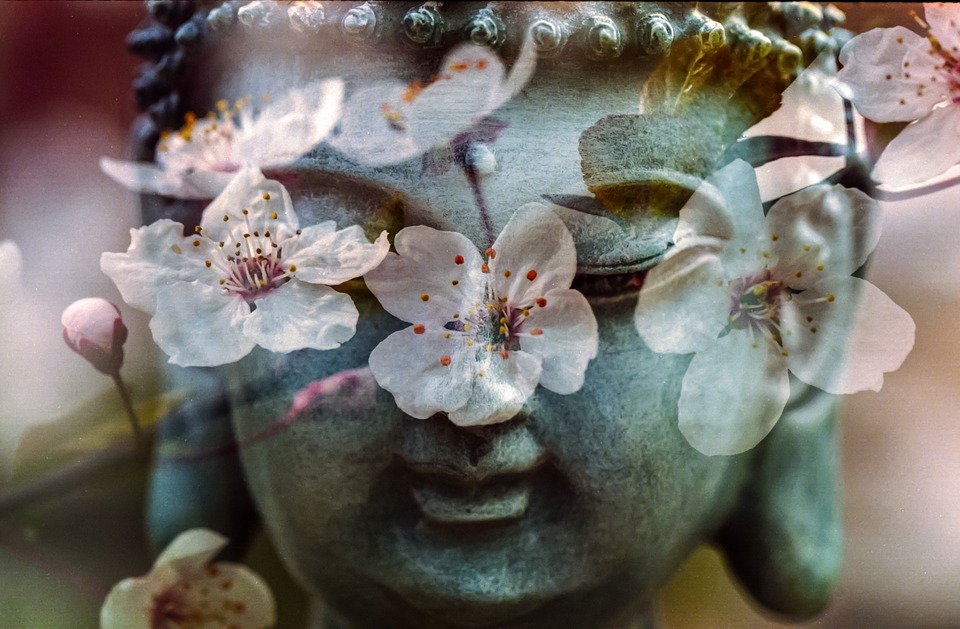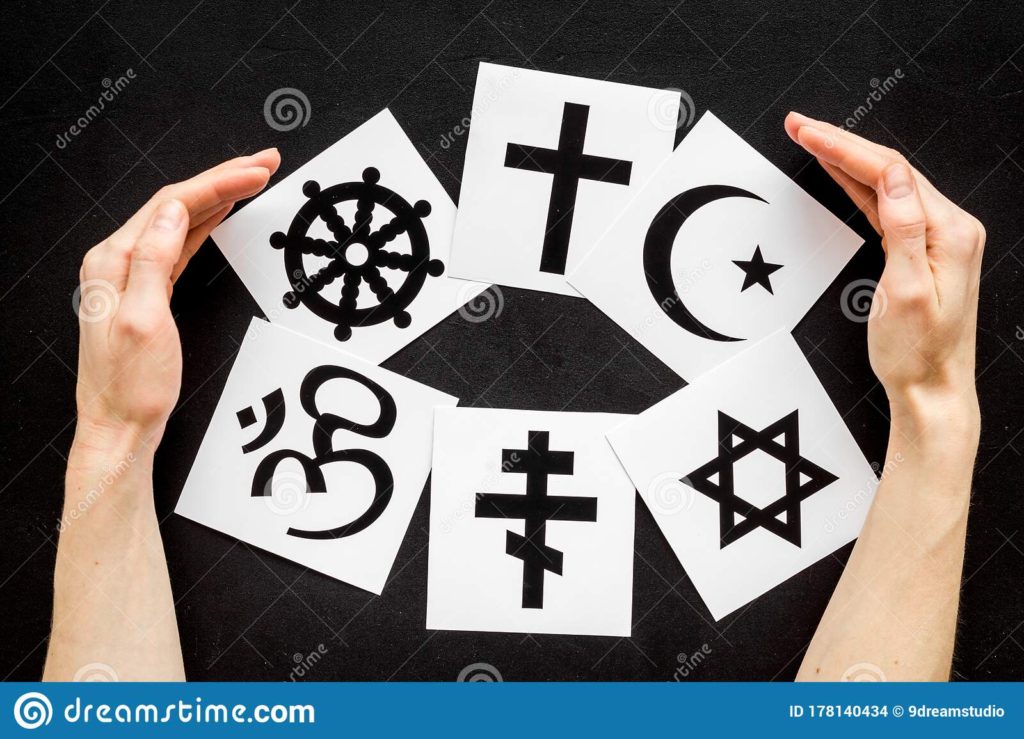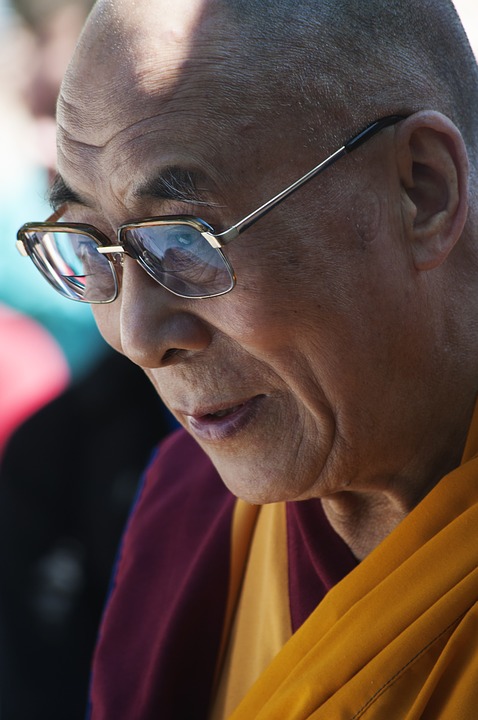To His Holiness the Dalai Lama, religious diversity is not a problem but the beauty and richness of human wisdom. It is like different flowers in a garden and different tastes of food. Yet, in human history, different religions of the world have often been a factor in many conflicts and divisions. Thus, His Holiness the Dalai Lama has committed to promoting religious harmony and coexistence between different world religions through:

“Whereas religious prayers sing of peace and harmony, religion has divided human beings through an atrocious history of enmity and bloodshed. Yet, behind the veil of superficiality and hypocrisy, I always believed in the inherent beauty of God that lies at the essence of all true spiritual paths.”
Radhanath Swami
- Dialogue between scholars of religion on the academic level;
- Dialogue between genuine practitioners;
- Meetings between the leaders of the faiths and
- Joint pilgrimage to holy sites.
Table of Contents
1. Dialogue between scholars of religion on the academic level
Dialogue between scholars of religion on the academic level can help us gain insight into the logic, ‘One Truth, One Religion; Several Truths, Several Religions’. Many religious-minded people have seen actual religious fights due to the ignorance and misconception that one’s own religion is the best for everyone and it is the one and only true religion. Or they misbelieve that all religious traditions are fundamentally one and so there will eventually emerge a truly universal religion in the world. So, lack of understanding of other religious traditions leads to suspicion and fear, bringing distance and mistrust between the traditions. For these sorts of problems, dialogues between scholars of religion on the academic level are a true solution.
To apply such a solution to the religion-driven problem is to have an open scholarly dialogue where the scholars have a shared opportunity to discuss both doctrinal and religious differences and similarities.
Open and Scholarly Discussion
Through open and scholarly discussions, one can come to understand that all religions are not fundamentally one and same in terms of both philosophical and traditional customs. For example, one can learn the fact that religions like Christianity are theistic while others like Buddhism are non-theistic religions. Philosophically, even within the Buddhist tradition, different schools of tenet exist. Furthermore, one can understand one’s own religion is neither the best for all people nor all human beings accept religious faiths.
Also, when one attentively listens to others and learn about other religions’ philosophical background behind the truth they accept, one can discover that the concept of ‘one truth, one religion, is better for individual matters while adopting the concept of several truths, several religions work for the human society where different mental dispositions exist. Here at the academic discussions, one can ask what the true purpose of these religions is despite the differences.
What is the main idea behind these philosophical differences? So by sharing knowledge and personal experience we expand the circle of our own world of understanding, and can finally reach a common ground accepting both the ability and necessity of different faiths to help the people lead a better life through various paths which fit their quest the most.

In this way, we can come to know that all religious traditions carry the same message of love and compassion, tolerance, and discipline although the philosophical visions are different. This can analogically be represented by the four blind men and the elephant. They had different perspectives based on the sides they touched and consequently, their descriptions of the elephant were different. Interestingly, a holistic description of the elephant was the description of all the blind men put together. Likewise, religiously, philosophically, by faith, one can see lots of differences in the world’s religious faiths, but all share the same goal and essence in creating more compassionate humanity.
There is no religion that is a panacea. Different religions are suitable for different people. For instance, different medicines are prescribed for different diseases. A medicine that is appropriate in one situation may be inappropriate in another. Thus we cannot simply say, “This medicine is the best.” so, His Holiness the Dalai Lama said at many Buddhist gatherings that he cannot say that Buddhism is the best religion for everyone although according to his personal disposition Buddhism is the best for him.
His Holiness, also, rightly said, “All these views –despite their different content and context-share the same goal and purpose in promoting human happiness”. Therefore, such discussions and dialogues between the scholars of religion are extremely helpful in drawing attention to the areas of convergences among the different faiths while accepting a deeper appreciation of the divergences of doctrinal teachings.
2. Dialogue between genuine practitioners
Dialogue between genuine practitioners will help promote “Faith in one’s religion, Respect for every religion”. Dialogue between true practitioners from different religious traditions will open deeper understanding and wider perspectives. . Sharing deep religious experiences is a very effective method to develop a genuine appreciation for other’s traditions.
If two different true practitioners, who have deep experience rooted in one’s own faith, meet each other and stay in dialogue, one can emotionally relate one’s religious experience to the other and start to experience the value in the other’s religious practices. One is able to appreciate other religious traditions and develop a true mutual friendship with other faiths.
For example, among His Holiness, the Dalai Lama’s many shared meetings and dialogues with other true practitioners from various religious faith, one such experience stands out. When His Holiness had visited an ancient Christian monastery in Europe and met with a Christian hermit who had spent five years as a hermit in a cave, he asked about the hermit’s practice during those years. The hermit replied without hesitation, “Meditation on love.”
His Holiness the Dalai Lama said, “When he said this, his eyes were moist and there was such depth of feeling. Upon hearing his simple response and sensing his presence, I was deeply moved.” Gazing into each other’s eyes, they had shared their presence and silence with one another for a brief but profound moment. They developed a respect for one another’s faith and deepened their faith in their own tradition.
Thus, His Holiness said, “This had a profound impact on me, especially with respect to the power of Christian contemplative practice.” So, this is a perfect example of how sharing of spiritual experiences between two genuine practitioners, can have a profound impact on one another. Therefore, meeting and having a dialogue between true practitioners of various religions help to bring religious harmony and mutual understanding by strengthening one’s faith towards one’s own religion and developing true respect for other world religions.
From my own experience, I also learned that personal dialogue with other religious practitioners has impacted us a lot and made us develop a deeper recognition of other traditions. I visited a wonderful Jain temple in Shravanbelagola, Hassan district in Karnataka, and met a genuine Jain master wearing nothing. His simple walking steps and compassionate appearance attracted me a lot at first sight. I asked why they do not wear any clothes. He answered me with three reasons by saying, “We abide by our vows, secondly, we don’t need to go for begging clothes and thirdly if we keep clothes with us and wash them, it leads to killing of the organism in water.”
His commitment to strict ahimsa has moved me a lot and convinced me of their dedication and devoted effort for the benefit of not only human beings but also small organisms. I thought, like this, if we think of others more and be less selfish, the message of love and compassion travel far and wide and world peace will be sooner at the door of our hearts. Since then, there is a special space in my heart for Jainism. So, listening to and meeting with true religious-minded people bring us mutual respect and special recognition for one another.
3. Meeting between the leaders of the faiths
Meetings between the leaders of the faiths and praying together from one platform makes us accept the reality, ‘One Goal, Many Ways’. Religions are meant for showing the path to happiness and bringing a meaningful life rooted in the feeling of love and compassion for one another. Unlike animals, religious traditions have evolved in human society out of human intelligence for a better human society. But out of lack of knowledge and experience in a broad way, some religious followers have a negative attitude towards other religious faiths and create unnecessary problems in the name of the religion. They fail to see the sameness at a deeper level but rather emphasize much on the differences.
To solve this problem, world religious leaders from different traditions should have a high-profile meeting to talk about the importance of religious freedom and religious harmony and stand in solidarity in the achievement of world peace and harmony. Such summits will help in setting a strong example to millions of followers all over the world, signaling the need to reach out to each other and to pray for the common goal of peace and service. So, this will create a friendly atmosphere where all human brothers and sisters share love and joy with one another despite the philosophical and historical differences.
I personally feel the power of other religious prayers too. Once I joined a Christian morning prayer at Dharmaram Chapel in Bangalore. The tune of that prayer, music, and gestures touched me a lot. Praying together with Christian brothers and sisters made me realize that there are more similarities than differences between Buddhist and Christian traditions. At the end of the prayer, a moment to share peace with one another by bowing down was extremely moving and a memorable part of my life.
For these reasons, I assure meetings between world religious leaders result in bringing all followers towards the common aspiration of world peace and lasting happiness through many different ways.
4. Joint pilgrimage to holy sites
Joint pilgrimage to holy sites of different world religious traditions not only helps us understand the history, struggles, and the development of different religious faith but also develops in us a deep respect for other faiths. This can be deeply felt when one makes the pilgrimage to different holy places. The problem is that many people who just live by their own religion judge all other religions faulty and guilty.
This is because of misinformation about other religions leading to communal and religious disharmony. To solve such a problem, one should not just believe in hearsay or what one hears and sees in the media. But rather, if different religious-minded people make a joint pilgrimage, one can truly learn about the values and importance of other traditions through one’s own experience.
His Holiness The Dalai Lama
Here, I think His Holiness the Dalai Lama is the best example who has made the pilgrimage to all holy sites of the major world religious traditions. He formally began this practice for himself in 1976 in India, when he visited and prayed at five holy places – Hindu temple, mosque, church, Sikh Gurudwara, and Jain temple – on the same day in Varanasi. Furthermore, when His Holiness went on pilgrimage to a church in Portugal, he actually saw Mary smiling at him which brought him profound experience at that time. I consider this is a sign of true respect and appreciation for other religions.

Thus, pilgrimage plays a key role in building mutual friendship and bringing true understanding among followers of different religious traditions.
In my own personal experience, it was my first time visiting a Mosque last year. This miracle happened in my life as a participant of the 15th interfaith program organized by the Foundation for Universal Responsibility of His Holiness the Dalai Lama. Before this pilgrimage, entering a Mosque and making friends with Muslims only filled me with fear and uneasiness. This was mainly caused by hearing and watching the news about ‘ Islamic Terrorism’. But when I visited the Mosque, I learned there are many wonderful practices of compassion and sharing peace.
For example, while meeting with one another, they greet in their language by wishing, “May peace be with you.” Also, we learned from Islamic imams about how to bow down and pray. I was moved by their devotion to God especially at the end of the prayer, turning their heads right and left, wishing for peace in those directions. For these reasons, going on a joint pilgrimage is an effective practice to promote greater religious harmony.
Therefore, adopting these four methods helps us appreciate the need for and the value of inter-religious harmony and mutual understanding as a solution to manmade problems like terrorism. Despite doctrinal differences, the message is the same. If you are a theist, see others as the children of God. If you are a non-theist, see all beings as your mother. Compassion is the essence of all religions. Let’s develop compassion for all.
Religious harmony quotes
Here we have listed some of the quotes on religious harmony.
- My religion is very simple. My religion is kindness. By Dalai Lama
- One should not think, my religion alone is the right path and other religions are false. God can be realized by means of all paths. It is enough to have sincere yearning for God. Infinite are the paths. By Sri Ramakrishna
- Harmony among our different religious traditions is essential for world peace. By Dalai Lama
- The enemy is not out there. The enemy is within you. How we see religion is in our mind. But religion itself is the truth peace and harmony. By Tenzin Dhonden
- All religions all this singing is one song. The differences are just illusion and vanity. The suns light looks a little different on this wall than it does on that wall, and a lot different on this other one, but it’s still one light. By Rumi
- The purpose of religion is to control yourself, not to critize others. By Dalai Lama
Related Articles
